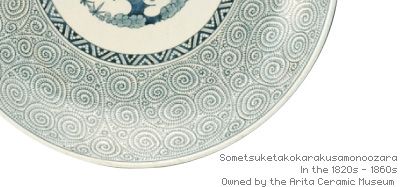


Depression in trade and the advent of big-name brand products Uniqueness wavering and restriction being removed in Arita ceramics
The stagnant depression in Arita around the end of the Tokugawa shogunate and a great fire in 1828 (Bunsei 11) caused the uniqueness of the Hizen porcelain industry to waver, while porcelain production began to flourish in the Mino and Seto regions. It was Yojibe Hisatomi, a wealthy merchant in Arita, who resumed the trade that had been on the decline since the first half of the 18th century. He became the sole agent and the first man to engrave his own brand name on his products. They are engraved with "Zoshuntei Sanpo-zo" (Made by Zoshuntei Sanpo).
The exclusive export by Hisatomi and others then provoked antipathy among other merchants and potters who wanted to export their products. Only 16 overglaze enamellers had been granted permission by the domain. The mounting demand for expanding permission drove the domain to give trade permission to 9 merchants such as Eizaemon Fukagawa and Ihei Hirabayashi. With the abolition of the domain system (han) in 1871, the Sarayama magistrate's office was closed. All the potters and overglaze enamellers that had previously needed the domain's permission to operate were now free to conduct business on their own.


 When walking along side streets in Arita, you will see brown earthen walls, called "tonbai-bei", which are limited to the Arita area. Tonbai square bricks of red clay and yakiko are used to compose the inner walls of the climbing kiln. They are characterized by the glass-like surface due to the exposure to very high temperatures in the kiln. Tonbai bricks left disused after the opening of a climbing kiln are recycled as hama (clay discs placed under porcelain pieces when firing), tochin (clay stands onto which porcelain to be fired is placed), and tonbai walls of bricks cemented with red clay.
When walking along side streets in Arita, you will see brown earthen walls, called "tonbai-bei", which are limited to the Arita area. Tonbai square bricks of red clay and yakiko are used to compose the inner walls of the climbing kiln. They are characterized by the glass-like surface due to the exposure to very high temperatures in the kiln. Tonbai bricks left disused after the opening of a climbing kiln are recycled as hama (clay discs placed under porcelain pieces when firing), tochin (clay stands onto which porcelain to be fired is placed), and tonbai walls of bricks cemented with red clay.